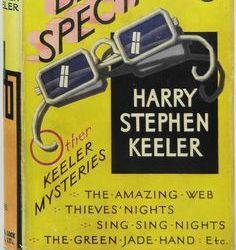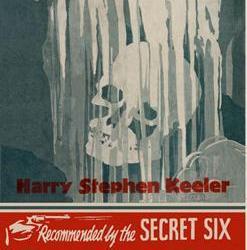#Ichabod Bertram
Photo







A few really dumb emojis I did for the Inferni Discord Chat for ‘Souls. Let it be known I only ever make super serious artwork always.
#'Souls RPG#Characters#Johnathan Withrop#Redtooth#Boone Lykoi#Nazario del Bosque#Ichabod Bertram#Briarblack#Aliyah#Coyotes#Coyote#Inferni#I swear to god i need to get back onto drawing serious things? Or at least TRY to draw actual things?#I just keep producing Goofball Junkstuff#anthro#forgot that tag whoops
4 notes
·
View notes
Text
The Greatest Bad Writer in America? Weird, Forgotten Harry Stephen Keeler

Harry Stephen Keeler (1890-1967) enjoys a peculiar kind of fame as a writer. Or "paper-blackener," to quote him. The prose of his mystery novels and pulp stories, written from the 1920s into the 1960s, can be simultaneously balled up, discombobulated, lyrical, cryptic -- even going "utterly blooey" at times. This is from The Riddle of the Traveling Skull, published in 1934:
For it must be remembered that at the time I knew quite nothing, naturally, concerning Milo Payne, the mysterious Cockney-talking Englishman with the checkered long-beaked Sherlockholmsian cap; nor of the latter's "Barr-Bag" which was as like my own bag as one Milwaukee wienerwurst is like another; nor of Legga, the Human Spider, with her four legs and her six arms; nor of Ichabod Chang, ex-convict, and son of Dong Chang; nor of the elusive poetess, Abigail Sprigge; nor of the Great Simon, with his 2163 pearl buttons; nor of--in short, I then knew quite nothing about anything or anybody involved in the affair of which I had now become a part, unless perchance it were my Nemesis, Sophie Kratzenschneiderwümpel--or Suing Sophie!

Viewed through the appropriate lens, Keeler's manifest flaws become avant-garde virtues, as he seems to stretch the novel towards some new form, possibly the radio play or podcast. Neil Gaiman is a fan: "My guiltiest pleasure is Harry Stephen Keeler. He may have been the greatest bad writer America has ever produced. Or perhaps the worst great writer. I do not know. There are few faults you can accuse him of that he is not guilty of. But I love him."
Among the various devotees keeping this "forgotten author" alive, no one has proven more steadfast than Richard Polt, who chairs the philosophy department at Xavier University in Cincinnati and founded the Harry Stephen Keeler Society. http://site.xavier.edu/polt/keeler/
Richard, give us an introduction to Keeler and his work -- and tell us what led you to dedicate so much time and energy to keeping his name alive.
I ran across Keeler by pure accident in 1996, and from the start I was thrilled by the feeling that I was onto something truly weird and forgotten. I’ve always enjoyed digging into some corner of culture, going deep enough that I discover things that just aren’t in sight of today’s conventional wisdom, and finding connections that I would never have found otherwise. That’s exactly what the world of Harry Stephen Keeler has done for me.
Keeler (1890-1967) was a lifelong Chicagoan. His father died when Harry was an infant, and his mother married a series of other ne’er-do-wells who also kept dying on her. Meanwhile, she ran a boarding house for vaudevillians—so Harry was exposed to a wide variety of theatrical types in a city that was teeming with immigrants. He studied to be an electrical engineer and worked for a while at a steel plant, but his real passion was writing. His mom feared that he was going insane, and had him committed to the asylum at Kankakee, Illinois in 1911-1912. But he was released, and managed to make a living publishing quirky little stories with twists. In 1919 he became the editor of the pulp magazine 10 Story Book, which published short fiction and pictures of half-clothed girls. He also edited magazines such as the Chicago Ledger and America’s Humor.
Keeler’s stories began to get more convoluted, and by the late ’20s he was publishing mystery novels with Dutton in the US and Ward Lock in England, including The Spectacles of Mr. Cagliostro, which drew on his experience in the asylum. Things were looking up, but the Depression cut into book sales at the same time as HSK’s novels took a turn for the bizarre. He typically built his novels on the skeleton of an old short story from his youth, or several of them woven together. Sometimes his wife, Hazel Goodwin Keeler, would also contribute a chapter. This all became the occasion for gloriously implausible tales, chock-full of long-winded speeches in dialect; caricatures of every ethnic group from “Swodocks” to “Celestials”; near-future technology such as intercontinental 3D television; and, inevitably, a surprise ending that sends your synapses on a rollercoaster ride. This stuff appealed to an ever narrower audience. Finally, Dutton dropped Keeler in 1942. He was published by the bargain basement Phoenix Press from 1943 to 1948. Ward Lock cut him in 1953. Then he wrote for Spanish and Portuguese publication at $50 a title—or just for himself.
There were definitely some bitterness and frustration in Keeler’s old age, and when Hazel died in 1960, he went into a tailspin. But then he married Thelma Rinaldo, his one-time secretary from America’s Humor, and as he put it, he caught hold of “the greased pig known as the will to live.” Harry collaborated with Thelma on some late novels that have been published only in recent years.
There are two perennial questions about Keeler: Was he mentally ill? And was he a bad writer? Most people’s initial reaction is that he was a terrible writer who had mental problems. But you can also make the case that he knew what he was doing and was very good at it; it’s just that he had an eccentric sense of humor that requires a special sensibility to appreciate. I’m inclined to this latter view, although he does keep me guessing. I suspect that he had some traits that we would classify as belonging to the autistic spectrum, such as a prodigious memory for facts combined with a superficial grasp of human emotion. A Keeler story is not about interiority; it’s about a complex plot that plays games with the reader’s mind.
Describe Keeler's trademark concoction, the "webwork plot."
“Web-work” or “webwork” was Keeler’s term for a highly complex plot, which weaves together a number of strands. He introduced the term in 1917 in a series of articles for The Student-Writer, which he then expanded into a fairly long treatise, "The Mechanics (And Kinematics) of Web-Work Plot Construction" (The Author and Journalist, April-November, 1928). Keeler never claimed to have invented the term or the concept; he gave credit to now-forgotten pulp writers such as Bertram Lebhar. But he did consider himself to be a skilled practitioner, and his fans would surely agree.
What’s most delightful in HSK’s theoretical writings on webwork is the diagrams, which show graphically how various characters and objects intersect at key moments in the story. "Mechanics" distinguishes 15 types of “elemental plot combinations” and presents a mind-blowing diagram of Keeler’s 1924 The Voice of the Seven Sparrows. It’s a very tortured plate of spaghetti.

Some of Keeler’s novels (including Sing Sing Nights, Thieves’ Nights, and the series Hangman’s Nights) get their complexity from a 1001 Nights structure: a framework story embraces several stories told by characters. Other Keeler novels get their complexity from endless digressions and red herrings, or tons of factoids that may or may not turn out to be relevant to the main story. Often, the action is told or retold by an unreliable character, instead of being shown to us directly. Inevitably, there’s a big surprise at the end that makes you see the whole plot differently in retrospect.
If you take away the surprise ending, webwork looks a lot like the contemporary literary genre sometimes called “hysterical realism”—the massive, weird, convoluted stories of writers like Pynchon. Keeler pioneered the formal analysis of this kind of tale. If you have a mathematical mind, you’ll appreciate his advice for getting a webwork started:
In conceiving a story or inaugurating a plot which involves threads weaving with threads, if the thread A, or viewpoint character, should figure with the thread B in an opening incident of numerical order "n" (with respect to the incidents in the conditions precedent) there must be invented a following incident "n + 1" involving threads A and C; an incident "n + 2" involving threads A and D; an incident "n + 3" involving threads A and E; and so on up to perhaps at least "n + 4” or "n + 5"; and furthermore "n" must cause "n +1"; "n + 1" must cause "n + 2"; "n + 2” must cause "n + 3" etc.
I’ve tried it—it works!
What's it like living in and among Keelerian natterings over the long haul?

Like one of Pynchon’s paranoid plots, or like Borges’ fantasy encyclopedia that ends up colonizing reality, the Keelerian world has many unsuspected strands that create a webwork in which I am now enmeshed. I’ve read more obscure authors because they imitated Keeler (John Russell Fearn) or were friends of his (T. S. Stribling). I found out that my own great-grandfather, Wells Hastings, wrote a mystery novel that can fairly be described as webwork. And I taught myself some Dutch in order to read the 2010 novel De Sciencefictionschrijver, by Harold S. Karstens—a story about a man who becomes unhealthily obsessed with Harry Stephen Keeler and starts a correspondence with Richard Polt. Yes, Keeler’s world is absorbing—to the point where I have now been absorbed within the covers of a fictional exploration of that world, to be discovered, like Harry himself, by future eccentrics.
by Daniel Riccuito
3 notes
·
View notes